
Our First Quince Harvest
Hello friends,
We have finally have had our first quince harvest. We planted a quince Smyrna tree back in the winter of 2022, and we've been waiting impatiently for a harvest since then.
The first year after sitting there as a stick over winter, the leaves budded, and then it flowered. But nothing became of the fruit, and we weren't worried because the tree was too small to bear the big quince fruit anyway. Over the spring and summer it grew slowly, which was fine with us, as it needed to develop it's root system.
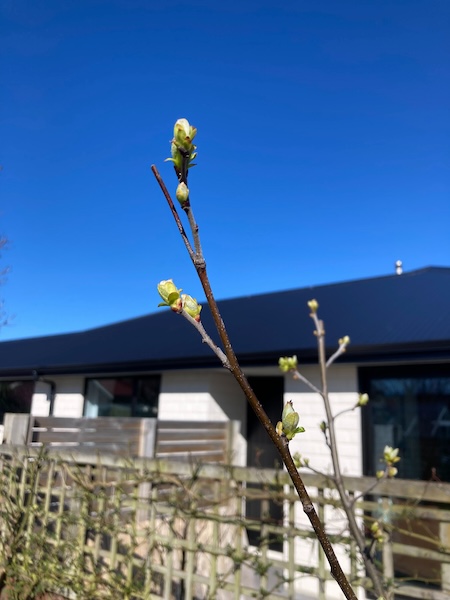
Winter came again, and once more it became a stick. And then the spring of 2023 the leaves unfurled, and the tree flowered again, but this time little quince fruit began to form. At the start there was about 10 fruit, but over the following weeks they started to drop off. Eventually 4 quince fruit remained.
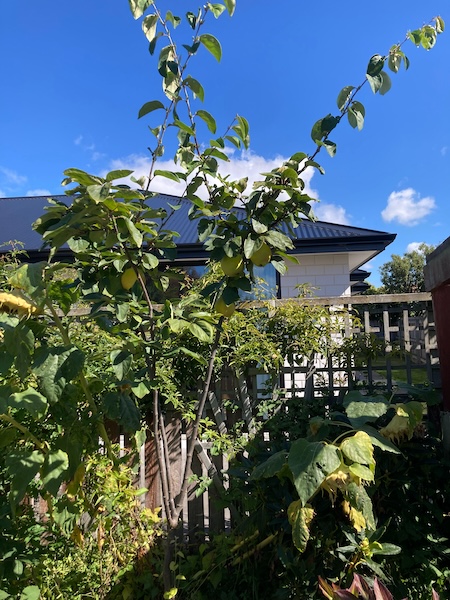
Over the spring and summer the fruit began to grow bigger on the tree. I was realistic in the fact that strong winds could knock them off, so I left them all there. By the time this autumn came, the 4 fruit remained, and they began to ripen to a pretty lemon colour.
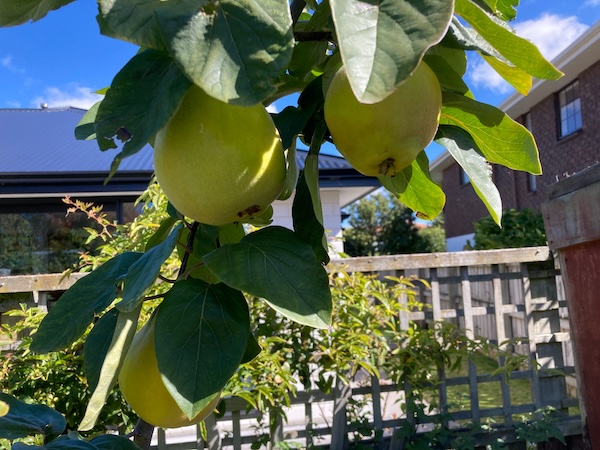
Ever since then we've been impatiently waiting for them to be ready to pick. I tested the fruit regularly to see if they were ready to harvest, by gently holding them and tipping them sideways. At first all four did not budge, so they were not ready. But then one day the two smallest fruit dropped into my hand when tested.
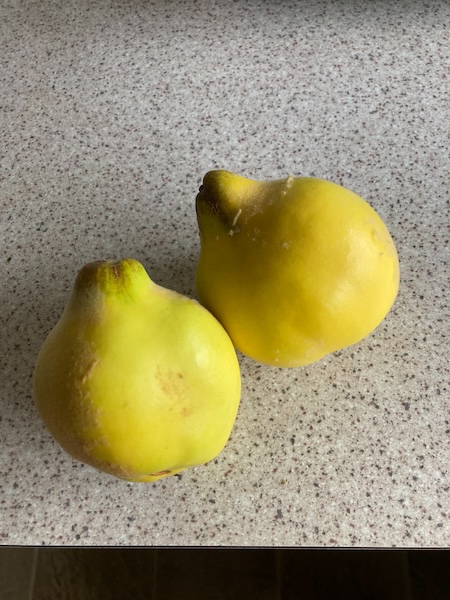
We had a couple of weeks more wait for the two biggest fruit to be ready to harvest. Luckily quince store well in the fridge, so when the last two quince were finally ready, it was time to poach the quince. We used our poached quince recipe, which you can find in a blog post here. This year we chose the vanilla and cinnamon combination for flavoring.

And the long wait for our own quince fruit was totally worth it, the poached fruit was aromatic and very tasty. And as a bonus we have lots in the freezer to enjoy over the year. And our quince tree is only a small tree, as it gets bigger much more fruit will ripen. My plan is to share them with family and friends and neighbours, and hopefully swapping them for other fruit we can't grow in the garden.
Have a wonderful day
Julie-Ann
Want to discuss my post? Feel free to chat with me on Instagram
or Mastodon or Bluesky.
Harvesting and Drying Alma Paprika
Hello friends,
This is our second year growing alma paprika plants. It's really satisfying to sow them as little tiny seeds, see them grow up into seedlings, and then onto big pepper plants with red peppers that you can dry into mild paprika.
The process for growing alma paprika plants is pretty much the same as any other capsicums or chillies. The seeds need to be sown in late winter, at the same time as tomatoes, and they need consistent steady heat in order to germinate. At that time of the year we have them sitting in the dining room where we have the fire going each day. Within a couple of weeks they germinate, and slowly over a couple of months they grow into seedlings which need to be potted on.
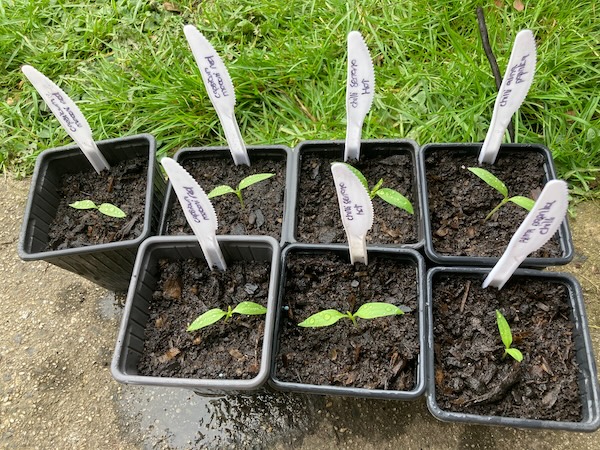
I move the alma paprika seedlings into the glasshouse in early October, and once it gets to Labour weekend, it's time to plant them into the ground in the glasshouse. Over the next few months they get bigger, and need staking, and at around Christmas they begin to flower. The rounded alma paprika fruits begin to grow, and then it's a wait over late summer and early autumn for the growing fruits to begin to change colour to a bright red hue.


Once the alma paprika fruit has turned red, it's finally time to pick them. I cut them off the plant using a pair of secateurs, and then take them into the kitchen to begin processing them.
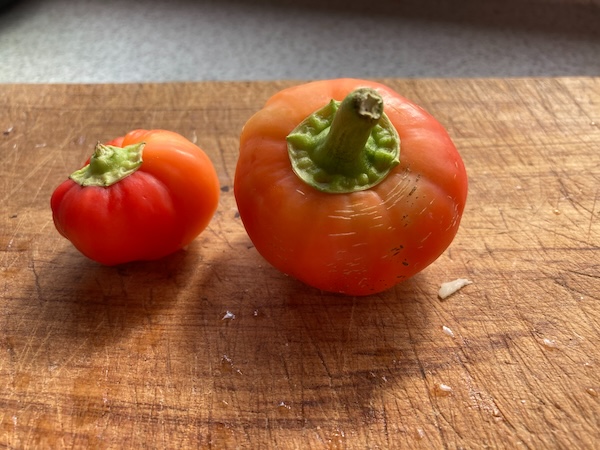
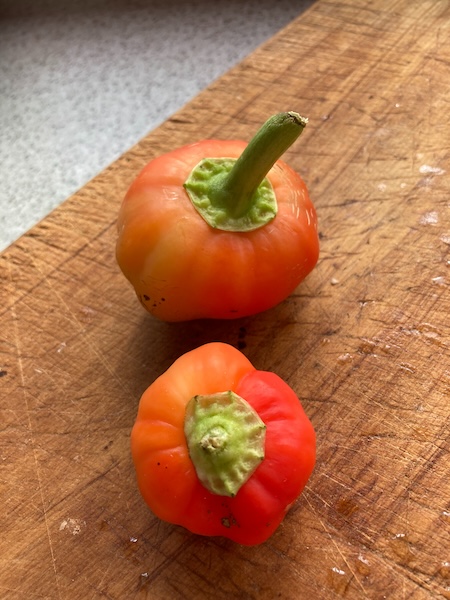
After chopping them in half, cutting off the stalks, and removing all the seeds, I slice the alma paprika fruit into thin slices and lay them out on a tray.
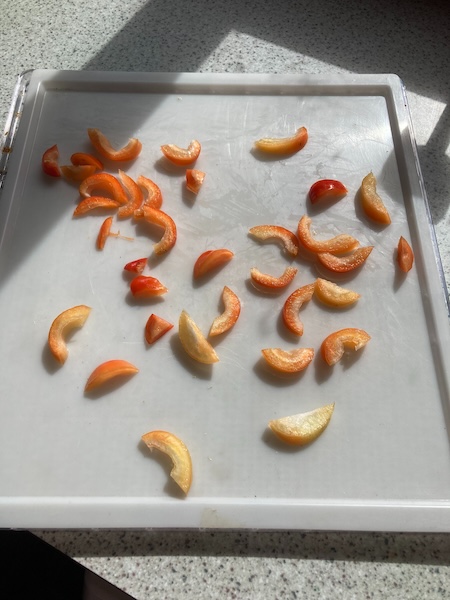
Then they go straight into the dehydrator at 35˚C, and I dry them until the slices are bone dry and brittle, ready for turning into paprika powder.
After a quick whizz in our spice grinder, the paprika powder is ready to use in cooking. The spice is tasty and mild, and works great in a number of dishes. The whole process is really easy, and satisfying, so it's now yet another yearly thing for me to do in the garden and kitchen.
Do you have any yearly tasks you enjoy? There's great satisfaction in accomplishing them when it means you have tasty food over the cold winter season.
Have a wonderful day
Julie-Ann
Want to discuss my post? Feel free to chat with me on Instagram or Mastodon or Bluesky.
Winter Solstice Hot Spiced Apple Juice
Hello friends,
And happy Winter Solstice to those of us in the Southern Hemisphere. It's a day for wrapping up warm in your winter jacket, hat, gloves,and scarf, and going for a walk in the chilly air, followed by coming home and cuddling up in front of a cozy warm fire (or putting one up on your TV if you don't have a fireplace).
And what better way to defrost from the cold than to make a pot of my favorite Hot Spiced Apple Juice, and then toasting with your loved ones to the coming of light. From this point on the days will slowly get longer, and eventually spring and summer will be on their way. I love the idea of the wheel of the year, and the perpetual cycle of winter followed, by spring, summer, and eventually autumn.
My spiced apple juice recipe is very easy to make, and because of the citrus and spices, your home will smell wonderful afterward, let alone the lovely taste of the spiced apple juice. Another wonderful thing about this recipe is that the slices of orange and lemons in the pot while cooking remind me of all the sunny days to come.
Spiced Apple Juice Ingredients (makes 3 liters, but I usually only make up 1L and cut back on the spices)
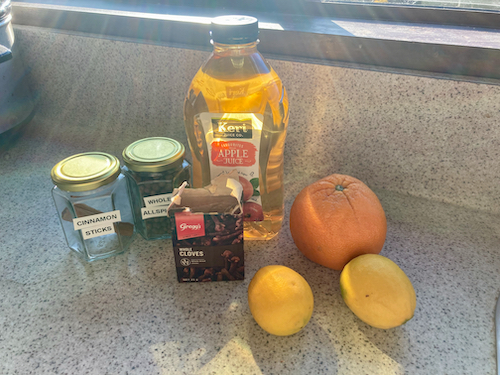
1 x 3L container of Apple juice
1 Orange
1 Lemon
1/2 Cup of Sugar
1/2 a Cinnamon Quill
4 Cloves
8 Allspice Berries
Spiced Apple Juice Recipe
1. Wash and then cut the whole lemon and orange into 1/2 cm slices. Remove all seeds before adding to the pot.
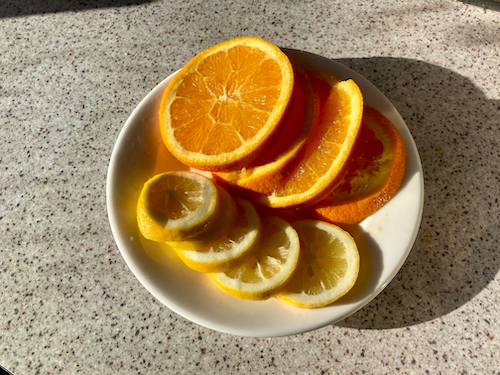
2. To a medium sized pot add all the ingredients.
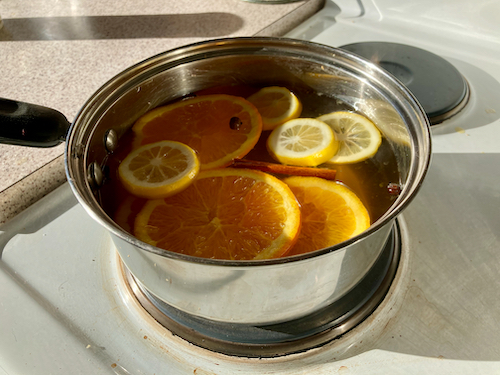
3. Heat the ingredients until simmering. Let the spiced apple juice continue simmering and taste test until it reaches your preferred taste. If you leave it too long the cinnamon, cloves, and allspice berries may get quite strong. I usually find 5 minutes simmering is enough.
4. Take the pot off the stove and sieve all the ingredients from the hot spiced apple juice.
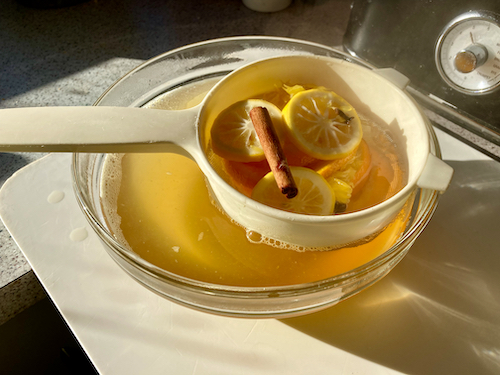
5. Serve in cute mugs, sip, and enjoy.

6. If you have any left over spiced apple juice, let it cool and store it in the fridge. It doesn't take long to heat back in up in the microwave for enjoying later.
I hope you love my recipe as much as I do, it's become a winter solstice favorite over the last couple of years. This recipe would also work wonderfully while celebrating Matariki, after waking up early to try and spot Matariki before dawn.
I find it hard to celebrate winter-themed Christmassy things in summer—when hearty food and drink are much more appreciated when the weather is colder. In our household we celebrate the winter solstice with hot spiced apple juice, a roast dinner, followed Christmas pudding with custard and ice cream.
Have a wonderful day,
Julie-Ann
Want to discuss my post? Feel free to chat with me on Instagram or Mastodon.




